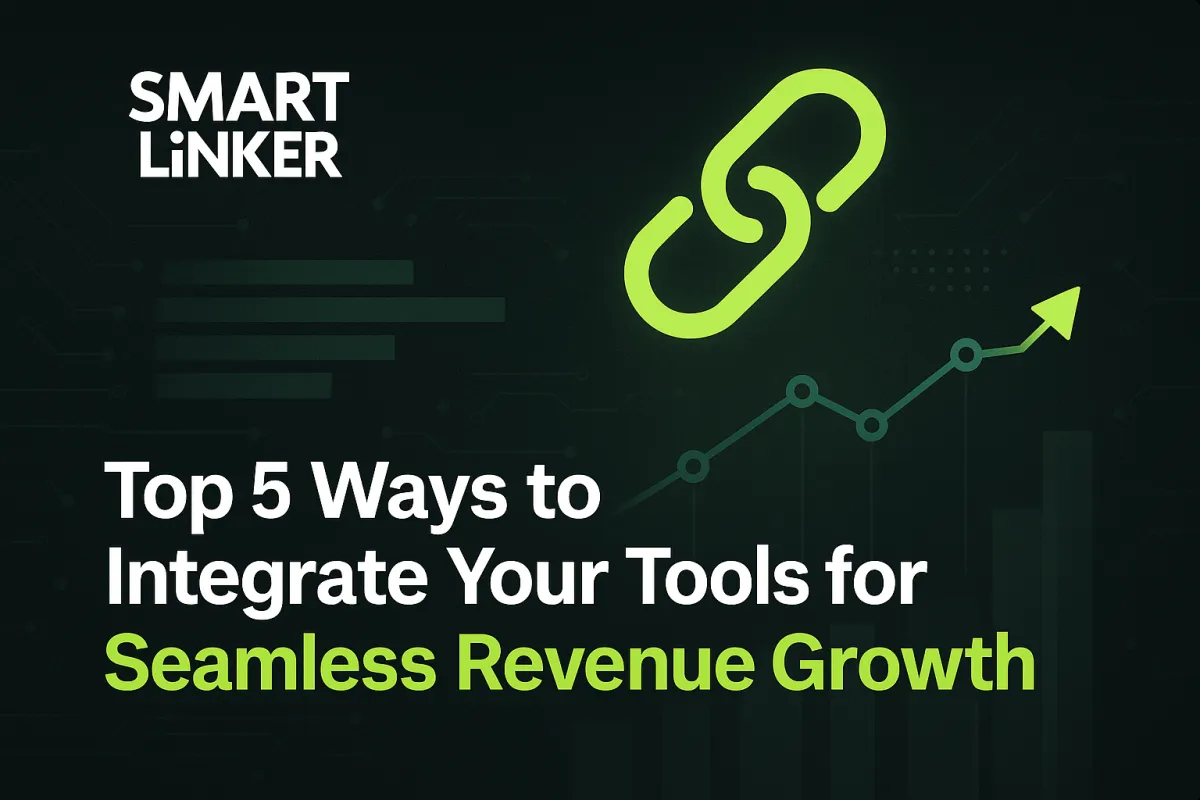
Top 5 Ways to Integrate Your Tools for Seamless Revenue Growth
Top 5 Ways to Integrate Your Tools for Seamless Revenue Growth
Tired of juggling platforms that don’t talk to each other? Double‑entry, lost leads, and missed appointments aren’t just frustrating—they’re costing you money and time that could be spent actually growing your business.
Think of Your Systems as a Symphony—not a Solo
Imagine your tech stack is like an orchestra—when every instrument plays in harmony, the result is powerful. But when one section misses a beat—like duplicate entries or unconnected platforms—it’s jarring. In this post, you’ll learn the top five tool integrations SmartLinker brings to the table, turning disjointed tools into a finely tuned engine that drives faster, smoother revenue growth.
EMR + CRM = Better Patient Communication
Why treat patient data like disjointed files instead of a care continuum?
Integrating Electronic Medical Records (EMR) with your CRM ensures every appointment, treatment note, and billing touch is visible. When your CRM automatically reflects patient history, you build trust and minimize errors.
Benefit: Patients receive proactive follow-ups after visits and custom reminders for check-ups or billing.
Data: 62% of patients say coordinated, proactive communication improves their experience and loyalty.
Expert insight: “Integrated systems reduce human error and reinforce trust,” says Dr. Melissa Tran, healthcare informatics lead.
Tip: Set up a rule: when an appointment is scheduled, automatically create a pre-visit reminder and send a post-visit check-in 48 hours later.
Stripe + CRM = Streamlined Billing
Who wants to chase down invoices when you could be closing deals?
Linking Stripe with your CRM lets you convert invoices to paid status automatically, trigger renewal reminders, and push receipts—all from a single dashboard.
Benefit: Leads no longer slip through the cracks at billing. Your team sees payment status in real time.
PWC study: Automated billing processes reduce revenue leakage by up to 20%.
Expert quote: “When payment becomes frictionless, retention improves dramatically,” notes Ayana Dewar, payments expert at Fintech Weekly.
Tip: Configure the CRM to automatically renew subscriptions 3 days before expiration and notify reps of failed payments.
Booking + CRM = Fewer No-Shows, Better Reminders
Booking apps are great—until no-shows hit your calendar.
Integrate your booking tool with CRM so scheduled appointments, cancellations, reschedules, and even intake forms update client records automatically.
Benefit: No-show rates drop by 30–40% when reminders and follow-up texts are automated.
Harvard Business Review: Automated appointment reminders reduce missed visits by 36%.
Pro tip: Automatically trigger a “One hour before visit” SMS reminder with a reschedule link.
Tip: After a no-show, set the CRM to send a follow-up email asking if they’d like to reschedule—plus an incentive or apology.
Calendar Sync = Smarter Scheduling
Time zones, booking links, and double-bookings? That’s a productivity killer.
When calendar systems are integrated, your availability is always up-to-date, meetings auto-populate in CRM records, and scheduling conflicts vanish.
Benefit: You avoid double-booking and reduce the admin time spent coordinating meetings by as much as 80%.
Source: RescueTime reports synced calendars can save professionals up to 200 hours a year.
User insight: “Once I integrated my calendar with CRM, I gained back an hour per day on scheduling alone.”
Tip: Allow clients to book directly via links sent by your CRM, with availability locked to prevent conflicts.
Custom Workflows = Automation That Works for You
No two businesses are identical—so why use cookie-cutter systems?
Custom workflows let you automate task routing, alerts, business rules, and even team hand-offs based on triggers—such as payment, stage changes, CRM tags, or completed forms.
Benefit: Teams respond faster and consistently, minimizing missed follow-ups.
Survey: 52% of sales teams say custom automation frees them to spend more time selling.
Thought leader: “Rule-based sequences ensure every prospect gets the same polished experience,” says automation expert Brian Lee.
Tip: Build a workflow: “If payment is received → assign onboarding task → wait 3 days → send mentoring check-in.”
Real-World Impact: When Integration Makes Magic
Scenario
Before Integration
After Integration
Impact
New patient booking
Manual admin tasks, delayed entry, missed follow-ups
Auto-logged, SMS reminders, intake forms attached
40% drop in no-shows, smoother onboarding
New subscription sale
Spreadsheet updates, manual invoicing, delayed follow-ups
Stripe pushes payment details into CRM instantly
15% increase in on‑time renewals, zero revenue leakage
Client follow-up
Forgotten or inconsistent follow-ups
CRM automatically triggers after set intervals
25% higher retention, fewer missed upsell chances
Getting Started: Integrate in 7 Steps
Audit Your Stack – List every tool and map where data flows start/end.
Identify Friction Points – Where is manual intervention or error slowing you down?
Choose Integration Strategy – Native connectors? Zapier? Or custom API work?
Plan Data Flow – Define what triggers what—e.g., Stripe payment → CRM update → onboarding sequence.
Build & Test – Start small: integrate one system, then scale.
Train Your Team – Make sure they understand workflows and benefit from them.
Track Impact – Monitor metrics like time saved, no-show rate, billing uptime, and revenue growth.
Integration Is Not Optional—It’s Essential
Disconnected tech stacks cost you more than money—they cost you momentum, professionalism, and growth. By integrating EMR, Stripe, Calendars, and CRM through SmartLinker, you end double entries, lost leads, no-shows, and admin drag—all while empowering your team to focus on what they do best: serving and growing your business.
Ready to make your tools work as one? Let the symphony begin.